|
|
| Home | Index | Museums | Blog | Authors | Site Map | About |
|
Stories of Mt. WashingtonSettlers Come to Mt. WashingtonbyMartha and Bill TreichlerTable of ContentsChapter 1We start our story of the settlement of Mt. Washington at the Town of Wayne end of the mountain with Ephraim Sanford. Ephraim Sanford came to the heights of Mt. Washington in 1793, the same year that Wm. Aulls and his son Thomas came to Pleasant Valley. Ephraim was a Revolutionary War veteran and a devout Baptist. He bought 1864 acres of land on the northeastern end of Mt. Washington from Jacob Hallett of New York City. |
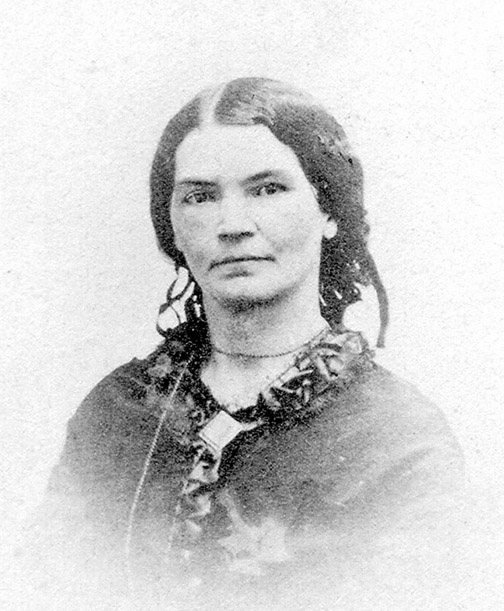 |
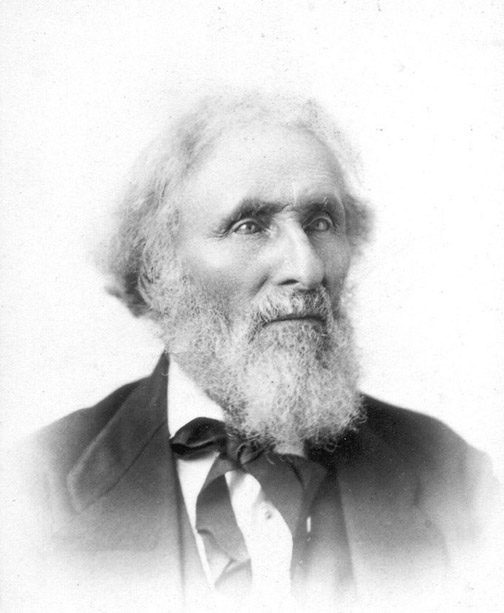 |
Benjamin and Mary Woodruff’s youngest daughter Sarah married James Vincent Glann, a son of other early settlers. Helena Howard gives us the story of the Glann family’s coming to Mt. Washington:
“According to a record found in the Sussex County Register’s office in Newton, New Jersey, John Glann, son of Jacobus and Anna Catlin Glann, married Naomi Drew, daughter of Gilbert and Susannah Drew, of Sussex County, New Jersey on April 17, 1813.
“They settled in Hammondsport, New York, high on a hill near Keuka Lake, which in those years was known as ‘Crooked Lake.’ Susan Glann Dildin, the fourth child born of the marriage of John and Naomi, is reputed to have related to her children a story of their early days in that location. That story has been handed down through the years to all her grand and great grandchildren. To the end that all the descendants of John and Naomi may know the story as told by Susan, the content is made a part of this narrative.
“Steuben County in 1813 was nothing other than a wilderness. The land they purchased was on a hill, called ‘Mount Washington,’ and it overlooked beautiful Keuka Lake. There they constructed their cabin.
“For a few years they depended mostly upon game for sustenance, and busied themselves in clearing the land. With this accomplished they were then able to raise corn, wheat and other grains, which they had to take to the nearest mill for grinding. This mill was located in Naples, New York, a distance of about thirty miles. In late fall after the grain had been harvested and threshed, and the snow had fallen, Mr. Glann together with some of his pioneer neighbors loaded their grain on sleds drawn by oxen to make the journey to Naples. As there were no roads through this wilderness they were forced to make one as they proceeded.
“The women and children were left alone for several weeks. They had no fear of Indian attacks as one might surmise. They were friendly and oft times exchanged game for a warm meal. The natives were constantly in fear of attacks by the wolves that roamed the territory. When the snow was deep and some times drifted as high as the eaves of the cabin the wolves mounted the roofs, and would come down the chimney if there were no fires to scare them away. It then was the task of the boys to keep plenty of wood on hand, and keep the fires blazing both night and day.
“Such memories should never be forgotten. They are inclined to warm our hearts and inspire our souls to properly evaluate and appreciate the work of our forefathers. Such a backward glance forcefully calls our attention to the hardships, wisdom and foresight that characterized the early pioneers. America, the beautiful as we know it today, was not created overnight, nor was it easily attained. The advantages we possess today were but the dreams of those of yesteryear.
“John and Naomi lived and died in Steuben County and are buried in their private cemetery near the old homestead.”
The 1857 Gillette and Levy map shows two J. Glanns owning land on the Mt. Washington Road.
Helena Howard is related to many of the early families on Mt. Washington through Mary Sanford Woodruff and Benjamin Woodruff and their children. The Sanfords had large families of children, as did most pioneer families and most of them married the children of neighboring families. I found piecing together these interlocking genealogies very difficult. Each family tended to use the same name in succeeding generations.
For instance, Elder Ephraim Sanford, the first settler on Mt. Washington, had a brother John. This John had a son John. And one of his siblings had a son John, so when a young woman farther along on the Mt. Washington Road marries a John Sanford, which one did she marry? Dates can be conflicting and missing. The Sanfords used the name Ephraim frequently, too. And Elder Sanford’s nephew Ephraim was also a Baptist pastor, well known in the community as Deacon Sanford.
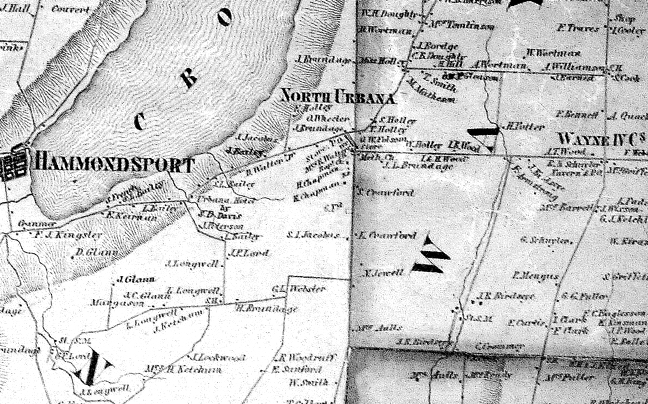
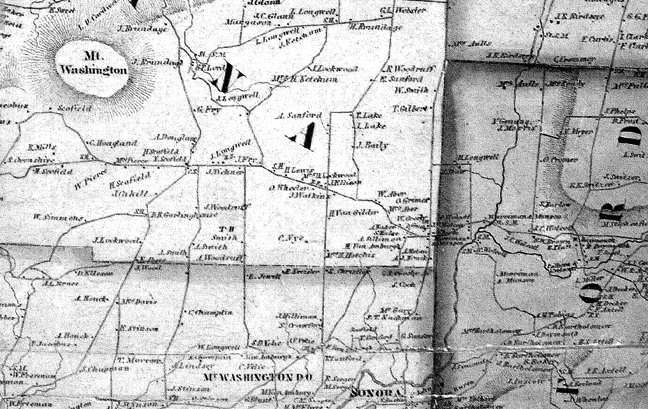
This section of an 1868 map shows both North Urbana and Mt. Washington. Mt. Washington is actually marked twice, but the northern one that is on the Mt. Washington Road is the one we have been researching. Perhaps the southernmost Mt. Washington is where the post office was located. Map is from Hamilton Childs Gazetteer and Business Directory of Steuben County, N.Y. for 1868-9.
Fortunately, Helena has records that Deacon Sanford was the son of John Sanford, and was born in 1817. His uncle Ephraim, the well-known Elder Sanford, was born in 1747 in Connecticut, so these two men cannot be confused.
Benjamin’s wife Mary Sanford and her family were loyal Baptists, but Clayton tells us that Benjamin Woodruff was a member of the M. E. (Methodist Episcopal) Church for fifty years, and was for many years a deacon. The 1857 Gillette and Levy map shows both churches at North Urbana, as well as a post office and several houses. Roberts tells us on p. 540 that “North Urbana is located on the east line of the Town of Urbana, contiguous to Wayne Township, and is distant from Hammondsport three miles. There are two churches (Baptist and M.E.), two blacksmiths shops and about half a dozen dwellings. Mail is received daily by stage from Dundee to Hammondsport and return.”
Mary Sanford Woodruff died in 1848, when the youngest daughter, Sarah, was only six years old, and in 1849, Benjamin married Julia K. Rowley. Twenty years later, in 1869, when Benjamin was 73 years old, he and Julia sold the farm to a neighbor, Henry Ovenshire, and with daughter Harriet, retired back east to Delaware. Sadly, he was not to enjoy his retirement. He died of “gastritis” in July of 1869, less than a year after he retired. His widow, Julia, moved back to Steuben County, and re-purchased the farm from G. L. Webster, who had bought it from Mr. Ovenshire. She lived there until her death, sometimes at odds with her step-children, family letters indicate.
At the same time that the Woodruffs, Longwells, Sanfords and other families were building a community around the center called North Urbana, settlers were arriving a few miles farther southwest along the Mt. Washington Road around the center that came to be known as Mt. Washington.
As we leave North Urbana, and go along the Mt. Washington Road, side roads lead off into the hills and dips. About four miles from North Urbana, there is a point where, within a quarter of a mile, there are three of these side roads: Woodhouse Road (recently renamed Bootjack Road), the Winding Stairs Road, and Hutches Road. Not surprisingly, a settlement grew up there, with a school, a church and parsonage, and several houses. Later a creamery was established just off Mt. Washington Road on Woodhouse Road. This settlement became the center of a community that stretched several miles in each direction. There was also a Mt. Washington post office that operated from 1836 until 1869, but we have not been able to find where it was located.
In the late 1790’s, settlers started to build log cabins on this stretch of Mt. Washington, attracted by the high-grade timber. Ruth King remembers that one of these log cabins was still standing in 1946, when she and her husband Dan bought their farm. Ruth interviewed an older neighbor, Mrs. Mabel Wood Spencer, about 1965, to see if Mrs. Spencer could remember any stories of these first settlers, since Mrs. Spencer was related to two of them, Joseph Wood and a John Sanford.
Mabel remembered many names of these early cabin builders and the locations of their cabins. These names were Ketchum, Jacobus (who had 21 children with two wives), Thomas Sanford, Shanley, Morris Hutches and Joseph Wood. The deed to Dan and Ruth King’s farm has different names on the different acreages of their farm. Some of these are Jacobus, Ketchum, A. Y. D. Baker, and the man who sold it to the Kings, Sherman Honeyman. Sherman had a large flock of sheep, and did lumbering and saw milling. From studying and comparing old maps, it is clear that land changed hands often.
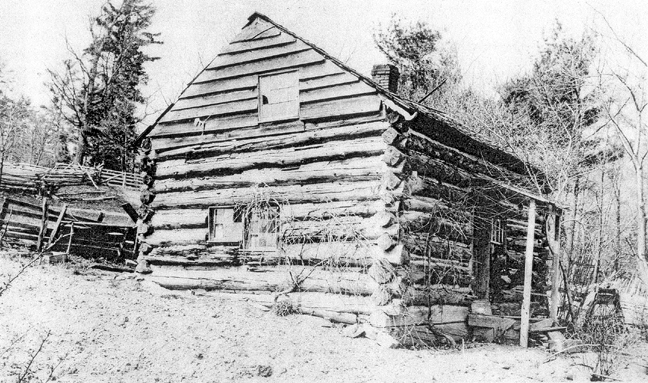
In the early 1800’s, other families continued to settle on Mt. Washington. Rufus Scofield came in 1816, and built his house about a mile west of the settlement of Mt. Washington. Thanks to his great grandson Lawrence Scofield, we have drawings of the plan of the house Rufus built. Fortunately, Lawrence also has photos of the house and farm taken in the 1920s. These photos are featured in our chapter on Architecture. The house is now gone, but we have the pictures, and we also have a wonderful diary, kept by his mother Bertha Lillian Fawcett Scofield, over many years, that is featured in our chapter on Families.
We can see the names on early maps of landowners along the Mt. Washington Road: Horace Ketchum, Elias Ketchum, Tyler Ketchum, William Aber, B. L. Retan, Steven Veley, J. Glann, Murray Nash, Jacob Fry, John Lockwood, Scofield, and Hutches.
Many of these names are still on roads that lead off the Mt. Washington Road, such as Veley, Hutches, Lockwood, Longwell, and until recently, Woodhouse. Maurice Hutches remembers that many roads have changed names. Not only has Mt. Washington Road become Route 113, but Aber Road has become Van Amburg Road. Damoth Road has become Longwell Road; Woodhouse Road has become Bootjack Road.
The descendants of several of these first families still live in Steuben County, and one of them, Joyce Woodhouse Garey (Mrs. Chester Garey), still lives on Mt. Washington Road. She is a niece of Mabel Wood Spencer, who was a granddaughter of first settler Thomas Wood. Joyce’s father, Leon Woodhouse, bought his farm from his father George, or Will, as he was known, and Will bought the farm from Elias Ketchum. Tyler Ketchum also had a farm on Mt. Washington Road. Maurice Hutches tells us that the area of Mt. Washington near Longwell Road was known as Ketchum Town, and the District #5 school at the junction of Mt. Washington Road and Longwell Road was called Ketchum Town School because of the number of Ketchum families who lived nearby.
Maurice Hutches and his wife Louise, and his nephew Don Hutches and Don’s wife Pat, are knowledgeable about the Hutches family history. They provided historic pictures, genealogy, diaries and real-life stories. We do not know the exact date that Nathan Hutches came to Mt. Washington, but we know that he died in 1845, and is buried in Mt Washington cemetery. His daughter Selecta married James B. Van Amburg, son of another early settler, and his son David married Malvira Dyke, an outlander. David’s daughter Stella married Fred Woodhouse, another familiar name among early settlers, and his son Andrew married Addie Longwell.
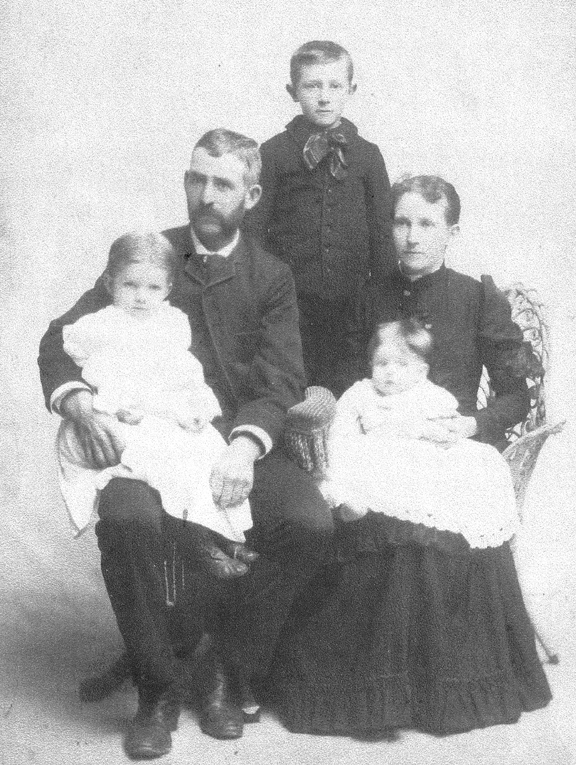
Andrew and Addie both died young, Andrew at 42, and Addie at 39, within a few months of each other. They left three young children: Clarence, 13 years; Clara Bell, 8 years, and Selecta (Jennie), five years. Neighboring families took in the children and brought them up. Selecta, whose name was changed to Jennie Ruth, was taken to New Jersey, but did come back to visit, and married a well-to-do engineer. Clarence went to live with his Aunt Stella and her husband Fred Woodhouse, a brother of Will Woodhouse, (Joyce Woodhouse Garey’s grandfather), and Clara Bell went to live with neighbors George and Margelia Aber on Aber Road, now Van Amburg Road.
Don Hutches grandfather Clarence married Josephine Schofield, apparently no relation to the Scofield family spelled without the h. Her parents were Thomas Schofield and Cora Nash Schofield. Cora’s parents, Murray and Betsy Beeman Nash, were also early settlers and neighbors. It is thanks to Pat and Don Hutches that we have photos of the Schofields and of some scenes of their life on a Mt. Washington farm. We show these photos in the chapters on Work and on the Architecture of Mt. Washington.
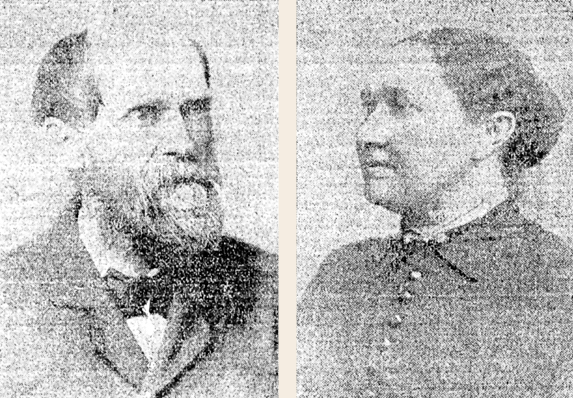
Below, the Nashes’ Golden Wedding announcement. Announcement courtesy of Pat and Don Hutches.
July 2, 1856, Betsy Beeman and Murray Nash were married at the home of the bride in Lawrenceville, Pa, The fiftieth anniversary of the event was celebrated on Monday at their home on Mt. Washington. Soon after their marriage they settled on a farm owned by the groom, near Lawrenceville. September 5, 1863, Mr. Nash enlisted in Company G, 161st N. Y. Vol. Inf. Shortly after enlistment he was placed on the non-commissioned staff as quarter master sergeant, serving in that capacity until mustered out at Fort Jefferson, in Dry Tortugas, September 20, 1865.
Mr. and Mrs. Nash are among our most estimable residents, having been prominently identified with the history of this place since moving to the farm now occupied by them, thirty-five years ago in April.
Mr. and Mrs. Nash were the parents of three children: Mrs. N. H. Van Amburg and Mrs. Thomas Schofield of this place, and a son, Charles M., who died at the age of four years. Mr. and Mrs. Nash are to be congratulated upon arriving at this mile stone with good health and in full possession of mental vigor.
Upon this visit their friends presented them with a handsome Morris chair and tendered the hope that they have many more years of health and happiness before them.
Perhaps the most famous inhabitant of Mt. Washington was Benjamin Bennitt, a lawyer and Civil War hero. Roberts gives a biographical sketch of Captain Bennitt, pp. 531 – 532.
“Benjamin Bennitt was born March 23, 1827, and died August 24, 1889. Almost with the first settlement of Urbana, and before the year 1810, the Bennitt family had established its homestead upon the west hills. Daniel Bennitt was a pioneer, and the father of a family remarkable for its size as well as the sterling qualities of its members. Among the youngest of Daniel Bennitt’s twenty-three children was Lieutenant-Colonel Benjamin Bennitt. With his father’s family he lived at the homestead until seven years of age, when the father, with ten of his children, took up the march of empire, and by means of wagon transportation emigrated to Steuben County, Indiana. After three years of life in the new country the father died, and the remnant of this mammoth family was broken up, never to be reunited. Benjamin returned to Urbana, and made his home with his sister, Mrs. Mary Hutches, upon Mount Washington. Here as a farmer boy he developed a mental and physical manhood that in after years served him well in his chosen profession, and in the stormy scenes that the great war for the preservation of the Union produced, and in which he was an active participant.
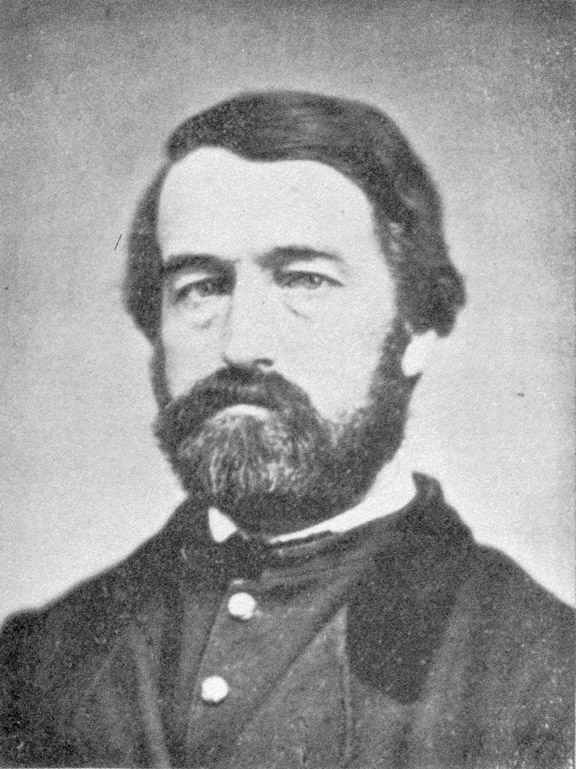
“Winters on the farm permitted attendance at school, and there was secured a good common school education, so that he at an early age evolved from scholar to tutor, and for a time he was a teacher in several of the different public schools in the town of Urbana. Ill health, however, unfitted him for farm work, and he turned his attention to Coke and Blackstone. He studied in the offices of the late Judge Jacob Larrowe of Hammondsport, and the late Judge Harlow Comstock of Canandaigua, and was admitted to the practice of law March 6, 1850. Subsequently he entered into partnership with Judge Larrowe, which continued until the call to arms in April, 1861. During the eleven years preceding the great conflict he grew rapidly as a lawyer and a man of affairs, and with the exception of the four years given to the service of his country, his life was spent in the practice of his profession in Hammondsport. During nearly thirty years he was justice of the peace; and served several terms as justice of sessions. As a lawyer he was thorough and conscientious in his work, and exercised a strong mind and a strong will in his many contests in the courts. His counsel was much sought, and his brethren of the law who knew him well were admirers of his abilities and valued highly his friendship.” Roberts tells us at some length about Major Bennitt’s heroic deeds during the Civil War.
“Major Bennitt was married February 8, 1854, to Melinda Wheeler, a daughter of Obadiah Wheeler of North Urbana,” Roberts, p. 534. Melinda was a sister of Mary Wheeler Gleason.